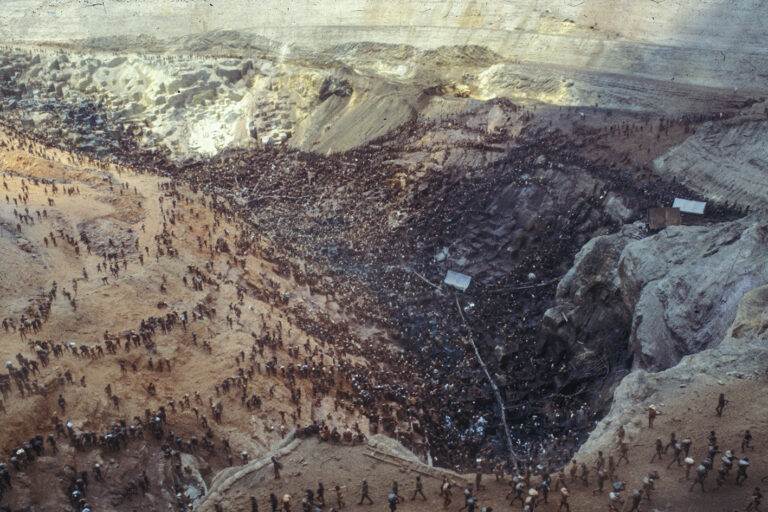Brazil’s wildcat mining is deeply rooted in its politics and thirst for minerals

Politics tamfitronics
- Brazil has had a long history of gold mining, going all the way back to the Portuguese empire. In the 1970s, as the country opened its forests for migration, many families headed for the recently discovered gold fields in Carajás, Tapajós, Roraima, Madre de Dios and the Guiana Coast and started exploring them, with support by governments.
- Wildcat miners or garimpeiros extract ‘free gold’ from secondary deposits using placer-mining technology. Gold-bearing mineral formations typically are classified as primary (hard-rock) or secondary (alluvial) deposits. In some regions, the success of the garimpeiros has attracted the interest of corporations, who know that alluvial gold is an indication of greater deposits being present.
- Garimpeiros have long been in conflict with Indigenous communities, who complain about their negative environmental impacts. But a renewed expansion of placer mining has also negatively impacted communities residing on agricultural landscapes.
Gold mining has been a feature of the Andean Amazon since pre-Colombian times and, along with silver, it was the cornerstone of the economy in the colonial and republican periods. In Brazil, gold mining was a source of wealth for the Portuguese crown and a major diver in the colonization of Mato Grosso and Rondônia during the eighteenth century. Guyana, Suriname and French Guiana all experienced nineteenth-century gold rushes, as did Venezuela in the first decades of the twentieth century. These historical events, however, have been dwarfed by the gold rushes of the modern era, all of which occurred after the United States ended the convertibility of the dollar in 1971.
The decision to untether international gold markets coincided with a decade marked by inflation that triggered an exponential increase in the price of gold. Coincidentally, Amazonian countries adopted policies to open their forest hinterlands to migration and development (see Chapter 6). The intent was to catalyze the expansion of the national economy via agricultural and mineral development. Structural obstacles and hubris doomed many initiatives, at least at first, but tens of thousands of families responded by migrating to the Amazon. Many headed for the recently discovered gold fields in Carajás, Tapajós, Roraima, Madre de Dios and the Guiana Coast.
These wildcat miners soon became adept at discovering alluvial gold, which they exploited with the full support of their governments. Corporate miners eventually followed, armed with information from high-quality geological surveys published by national mining ministries. Those technical documents disseminate information at a relatively high level, but the presence of gold must be verified and validated by field work. This is the domain of junior mining companies, whose field geologists knew the best places to look for gold is to follow the lead of the wildcat miners.

Gold-bearing mineral formations typically are classified as primary (hard-rock) or secondary (alluvial/colluvial/saprolite) deposits. The presence of secondary deposits is an indication of the existence of a primary deposit. Wildcat miners extract ‘free gold’ from secondary deposits using placer-mining technology. This type of mining will eventually end in the Amazon – either when authorities limit its expansion or when wildcat miners discover and exploit all the accessible secondary deposits. Long before this occurs, however, the gold mining sector will have transitioned to the more lucrative hard-rock mining production model.
Hard-rock deposits have two manifestations: (a) high-grade lodes and veins located in faults or shear zones within a rock matrix; and (b) low-grade ore bodies where gold is tightly bound in low concentrations within the mineral matrix of the rock. Some medium-scale miners have already made the transition to hard-rock mining using underground mines and cyanide to exploit the high-grade ores. Low-grade ores will be exploited by corporations operating open-pit mines within, or near, landscapes already blighted by the scourge of placer mining.
Politics tamfitronics The Tapajós mining
Gold mining started in southwest Pará in the late 1950s when garimpeiros discovered alluvial deposits on the Río Crepori, a tributary to the Rio Tapajós located about 500 kilometres south of the port city of Santarém (Figure 5.22). Access was limited by what small airplanes could ferry into remote airstrips or hauled upriver and ported around several sets of rapids. The earliest miners used the most rudimentary placer technology and cleared ~1,540 hectares of riparian forest by 1975. Migration increased after the construction of the trunk highway (BR-163) that connected Cuiabá with Santarem in the late 1970s (see Chapter 2). Tens of thousands of garimpeiros poured into the region and, by 1984, the spatial footprint of the Tapajós Garimpo had tripled to 4,750 hectares and access to the region was improved by the construction of the Estrada Transgarimpeira, which allowed miners to expand the scale of their activities with heavy equipment. The area of floodplain forest lost by 1993 surpassed 16,500 hectares.
Gold production increased from eight tonnes annually in 1970 to more than 26 tonnes by 1990, but the nominal value increased from only US$7 million to US$175 million – a very large sum in the Amazon of the late 1980s. The price of gold stagnated in the 1990s; nonetheless, miners still managed to produce between eight and twelve tonnes per year. The rebound of gold prices after 2007 led to another boom in mining activity, increasing the total spatial footprint to 26,170 hectares by 2015. Compared to the deforestation caused by cattle ranching, this might appear not to be a particularly large area. However, the forest destroyed in the Tapajós gold fields is almost always floodplain forest.

In 2013, a newspaper in Santarem estimated the region had produced about 758 tonnes of gold over fifty years with a value calculated at ~R$79 billion (then ~US$25 billion). The purpose of the newspaper article was to protest lost public revenues from gold miners that had only recently started paying royalties. Gold production from the region in 2013 was reported at twelve tonnes, which would have had a nominal market value of ~US$447 million; however, only R$1.6 million were transferred to the municipality of Itaituba, roughly seven per cent of the putative amount actually owed (R$24 million). Annual receipts have improved steadily since, as medium-sized companies and cooperatives began operating within the formal sector. In 2019, a total of R$64 million in royalties were transferred to the municipality corresponding to, perhaps, fifty per cent compliance with their obligations under Brazilian law.
In 2020, a regional news service estimated there were 2,700 active garimpeiro mine sites employing ~27,000 individuals. Some are reworking pre-existing placer mines using more sophisticated technology, but the placer-mining footprint continues to expand up secondary and tertiary tributaries of the Crepori and Jamanxim. Satellite images reveal that between 3,000 and 4,000 hectares of floodplain forest were lost each year between 2010 and 2020. At least some garimpeiros have evolved into small-scale hard-rock miners and are now exploiting the more easily accessible primary gold deposits. There was only two industrial-scale underground mine operating in the region in 2020, but junior companies were developing four underground and three open-pit mines (see Figure 5.22), while conducting exploration campaigns across the region.
Most of the mining has taken place within the Área de Proteção Ambiental (APA) do Tapajós, a conservation category that allows mining; nonetheless, most mines are considered illegal because they do not comply with environmental or fiscal regulations. The region also contains two national parks (Jamanxim, Rio Novo) where mining is not allowed, and five national forest reserves: Floresta Nacional (FLONA) Itaituba I and II, where mining is allowed, and FLONA Amaná and Jamanxim where it is not. All are still in early stages of consolidation and are under pressure from settlers, land grabbers and wildcat miners. In 2017, the administration of Michel Temer attempted to reduce the size of and recategorize the FLONA Jamanxim, but the move was declared illegal by the Supreme Court of Brazil.
Most of the mid sector of the Tapajós watershed was once the undisputed domain of the Munduruku, an Indigenous nation that has struggled to coexist with the garimpeiros and to protect the region’s ecological integrity. A relatively numerous tribe, they now mainly reside in riverside communities in their legally constituted territories (TI Munduruku, TI Sai Cinza and TI Sawré Muybu), all of which are adjacent to the gold fields. Their communities continue to suffer territorial encroachment, particularly along the Rio das Tropas and Rio Cabituto. In 2014, they created the Movimento Ipereg Ayu , a self-protection force, whose first act was to ‘self-demarcate’ their land and organize patrols to combat illegal mining and logging.
Politics tamfitronics Eastern Pará
The most famous gold mine in the Brazilian Amazon is Serra Pelada in Eastern Pará, the site of a gold rush that started in 1981 and ended with the closure of the world’s largest hand-dug, open-pit mine in 1993. At its peak in the mid 1980s, the population of miners reached 80,000 men and boys, while tens of thousands of women and children lived in adjacent settlements. Today, Serra Pelada is surrounded by farms and ranches, but in 1981 it was a forest frontier and, predictably, a chaotic and violent garimpo.
The gold rush occurred in the heyday of the military government that sent an officer familiar with the region to manage the mine, which was quickly becoming famous for its chaos and hellish working conditions. Sebastião Rodrigues de Moura, known by the sobriquet Major Curió, imposed order using a combination of coercion, persuasion and common sense. The garimpeiros organised themselves into the Cooperativa de Mineração dos Garimpeiros de Serra Pelada (COOMIGASP). The concession was originally held by a subsidiary of the state mining company (Companhia Vale do Rio Doce – CVRD), which ceded ownership to COOMIGASP in 1982 once it was obvious that social conditions would make it impossible to develop an industrial mine.

The tropical rains eventually surpassed the ability of pumps to keep the pit free of water, while its haphazard design and the unconsolidated lateritic soils (saprolite) led to multiple recurring landslides that killed dozens of workers. The mine was closed in 1992, even though there were abundant gold resources yet to be fully exploited. The amount of gold that came out of the Serra Pelada is conservatively estimated at 42 tonnes, which at the time would have represented ~US$500 million. The true amount is presumed to be greater because the bank tasked with purchasing the miners’ production only paid 75 per cent of the international market price.
The Serra Pelada ore body is known to extend several thousand metres below the surface and is estimated to contain an additional ~100 tonnes of gold as well as platinum (~35 tonnes) and palladium (~18 tonnes). The garimpeira cooperative has neither the technical capacity nor the financial resourc es to develop the resource. However, in 2000, COOMIGASP entered into a joint venture with a Canadian company (Colossus Minerals) to install an industrial-scale underground mine. The initiative was not successful, due to the complex social dynamic that required the Canadian company to enter into a business venture with an unruly association of garimpeiros.
The cooperative, which now boasts 45,000 members, continues to seek partners and opportunities to reopen the shaft sunk by Colossus between 2000 and 2014. In January 2022, COOMIGASP received a commitment from the Bolsonaro administration to reactivate the mine, a decision influenced by the memories of his father’s experience as a garimpeiro at the mine in the early 1980s.

Serra Pelada was just one of several garimpos that benefitted from federal programmes in the 1980s; direct subsidies included technical assistance, financial services, air transport, health care and food. The highest profile federally sponsored garimpo was the Projeto Cumaru, which was located on a remote forest landscape on lands inhabited by the Gorotire tribe of the Kayapó nation. The surge of migrants overwhelmed the Gorotire, whose leaders originally sought an accommodation with the garimpeiros in exchange for a share of revenues and the delimitation of their territory. The Kayapó quickly got tired of the accommodation, once they experienced the impacts on their health and livelihoods – and realised they were being cheated out of revenues. Mining activity declined through the 1990s as the value of gold experienced a cyclical decline, but miners once again poured into the area after 2015. The Kayapó are resolute in their opposition to mining, but they have been unable to protect their territory, despite assistance from the public prosecutor’s office and civil society.
The popular press emphasizes the conflict between Indigenous people and garimpeiros, but the renewed expansion of placer mining has also negatively impacted communities residing on agricultural landscapes. Tens of thousands of garimpeiros were attracted to Eastern Pará during the 1980s and, although some relocated elsewhere, many settled in INCRA-sponsored settlements that characterise the region. This demographic reserve of garimpeiros, or their descendants, emerges when the price of gold spikes. Some invade Indigenous areas, but others reoccupy the abandoned garimpos of the 1980s that are now surrounded by farms and ranches. Satellite imagery reveals new placer mines have destroyed thousands of hectares of riparian habitat and remnant gallery forest in the municipalities of Xinguara, Rio Maria, Curionópolis and El Dorado de Carajás.
As in the Tapajós, the success of the garimpeiros has attracted the interest of corporations, who know that alluvial gold is an indication of greater deposits locked away in the ore bodies of the Greater Carajás mineral province. Vale operated an industrial gold mine at Igarapé Bahia between 1990 and 2000 that produced ~100 tonnes of gold and about ~US$1.6 billion in gross revenues. Today, corporate interest is focused on copper and nickel as the primary target minerals; nonetheless, these mineral (IOCG) deposits also produce gold. In 2021, the Sossego and Salobo mines produced, respectively, two and ten tonnes of gold, representing about 25 per cent of their combined revenues of US$ 2.5 billion.
Banner image:
“A Perfect Storm in the Amazon” is a book by Timothy Killeen and contains the author’s viewpoints and analysis. The second edition was published by The White Horse in 2021, under the terms of a Creative Commons license (CC BY 4.0 license).
To read earlier chapters of the book, find Chapter One hereChapter Two hereChapter Three here and Chapter Four here.



 Hot Deals
Hot Deals Shopfinish
Shopfinish Shop
Shop Appliances
Appliances Babies & Kids
Babies & Kids Best Selling
Best Selling Books
Books Consumer Electronics
Consumer Electronics Furniture
Furniture Home & Kitchen
Home & Kitchen Jewelry
Jewelry Luxury & Beauty
Luxury & Beauty Shoes
Shoes Training & Certifications
Training & Certifications Wears & Clothings
Wears & Clothings















